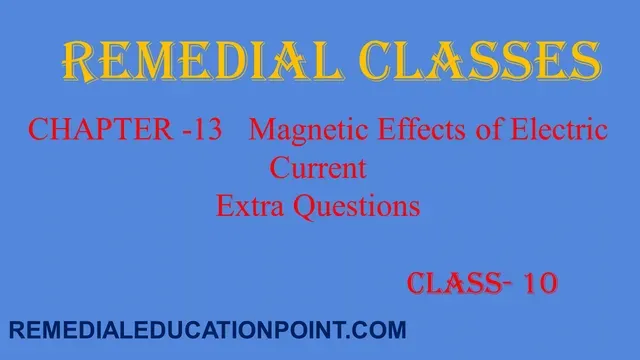Here, you are provided Class 10 Science Chapter 13 Extra Questions
Physics. In Class 10 Science Chapter 13 Extra Questions, you will find extra questions for better practice that will help you in your board exams. when you study Class 10 Science Chapter 13 solutions, then these extra questions can be solved.
 |
| Class 10 Science Chapter 13 Extra Questions |
Class 10 Science Chapter 13 Extra Questions
Class 10 Science
Chapter 13 Extra Questions consist of topics- properties of the magnet, artificial magnet, magnetic field and
magnetic field lines, properties of magnetic field lines(force lines), magnetic
field due to straight current-carrying
conductor, Right-Hand thumb rule, magnetic field due to current through a
circular loop, clock rule, solenoid, electromagnet, Fleming’s left-hand rule and Fleming’s right-hand rule, Electromagnetic Induction, AC generator and DC generator, electric
motor, use of Magnetism in medical science.
Class 10 Science Chapter 13 Extra Questions
If you find any difficulty in finding answers to Class 10 Science Chapter 13 Extra Questions then go through NCERT solutions of class 10 science or you can comment in the comment section, we will be very pleased to help you
CHAPTER- 13- MAGNETIC EFFECTS OF ELECTRIC CURRENT
1.
What is a magnetic field?
2.
What is the unit of magnetic field strength?
3.
Draw a labeled diagram of a simple electric
motor.[Annual exam-2012]
4.
Write the four properties of the field line of
the magnetic field. Draw a diagram indicating lines of a magnetic field inside
and around a current-carrying solenoid. How an iron rod can be converted into a
magnet using a current-carrying solenoid? Describe using a suitable diagram.
[Annual exam-2012]
5.
Draw a labeled diagram of an electric
generator.[Annual exam-2013]
6.
What is a magnetic field? Draw a magnetic field
line around a bar magnet. Write down four characteristics of magnetic field
lines. State the rule for finding the direction of the magnetic field associated
with a current-carrying conductor.[Annual exam-2013]
7.
Why do magnetic field lines not intersect each
other?[Annual exam-2013]
8.
What do you mean by magnetic field lines?
9.
Show the magnetic field or force lines around
a bar magnet with a diagram.
10. Why does a compass needle get deflected when
brought near a bar magnet?
11. Describe an activity showing the direction of
magnetic field lines around a bar magnet.
12. Describe the rules to find the direction of a magnetic field around a current-carrying
conductor?
13. Describe the following rules-
i. Right hand thumb rule
ii. Fleming’s left-hand rule
iii. Fleming’s right-hand rule
iv. Maxwell’s corkscrew rule
14. Draw magnetic field lines around a current-carrying
circular loop.
15. What will be the effect on the magnetic field
produced by a current-carrying conductor if turns in the coil are increased from
n to 2n?
16. Why is the magnetic field increased if turns in a
coil increase?
17. What is the relation between the magnetic field in the current-carrying conductor and distance?
18. How can it be shown that a magnetic field exists
around a wire-carrying current?
19. What indicates that the magnetic field is the
same at all points in a solenoid?
20. Give the factors that affect the strength of the magnetic field at a point due to a straight current-carrying conductor.
21. Name two organs in the human body where a magnetic
field is produced?
22. Write the full form of MRI?
23. What is MRI?
24. Name any two devices which use permanent magnets.
25. What is a commutator?
26. Name the device that reverses the direction of
flow of current through a circuit.
27. What is armature?
28. What are the three essential parts of a generator?
29. Name a device that works on the principle of
electromagnetic induction.
30. List the properties of magnetic force or field
lines?
31. Why don’t two magnetic field lines intersect
each other?
32. What is a solenoid? Draw a diagram.
33. What is an electromagnet?
34. Describe an experiment showing the direction
of the force on a current-carrying conductor in a magnetic field. Draw a diagram
also.
35. Explain the rule to find the direction of
force on a current-carrying conductor in a magnetic field.
36. What is the principle of an electric motor?
37. What is the role of spilt ring in an electric
motor?
38. State Fleming’s left-hand rule.
39. What do you mean by electromagnetic induction?
40. Describe the construction and working of
electric motor. Draw the diagram also.
41. Describe the construction and working of an electric generator. Draw the diagram also.
42. What is a galvanometer?
43. Who discovered the electromagnetic induction
and laws of electrolysis?
44. What is electromagnetic induction?
45. Describe the rule to find the direction of
induced current in a coil placed in a magnetic field.
46. Explain different ways to induce current in a
coil.
47. Draw a schematic diagram of a common domestic
circuit.
48. Name two safety measures commonly used in
electric circuits and appliances.
49. What is a short circuit?
50. What is overloading?
51. What is a fuse?
52. Name some devices in which electric motor is
used?
53. When does an electric short circuit occur?
54. What is the function of an earth wire? Why is
it necessary to earth metallic appliances?
55. What is the frequency of AC (alternating
current) we receive in our houses?
56. Which two circuits are used in our houses?
57. State the principle of an electric generator?
58. Name some sources of direct current?
59. What are the main differences between AC
generator and DC generator?
60. What is an electric motor?
61. What is an electric generator?
62. What are the types of electric generators? Give
names.
63. Write the difference between the A.C. generator and the D.C. generator.
64. What is the advantage of AC over DC?
65. Draw a schematic diagram of a common domestic
circuit.
66. When is the force experienced by a current-carrying conductor placed in a magnetic field largest?




No comments:
Post a Comment